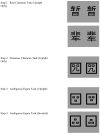The roles of visual expertise and visual input in the face inversion effect: behavioral and neurocomputational evidence
- PMID: 18226826
- PMCID: PMC2267768
- DOI: 10.1016/j.visres.2007.11.025
The roles of visual expertise and visual input in the face inversion effect: behavioral and neurocomputational evidence
Abstract
Research has shown that inverting faces significantly disrupts the processing of configural information, leading to a face inversion effect. We recently used a contextual priming technique to show that the presence or absence of the face inversion effect can be determined via the top-down activation of face versus non-face processing systems [Ge, L., Wang, Z., McCleery, J., & Lee, K. (2006). Activation of face expertise and the inversion effect. Psychological Science, 17(1), 12-16]. In the current study, we replicate these findings using the same technique but under different conditions. We then extend these findings through the application of a neural network model of face and Chinese character expertise systems. Results provide support for the hypothesis that a specialized face expertise system develops through extensive training of the visual system with upright faces, and that top-down mechanisms are capable of influencing when this face expertise system is engaged.
Figures








References
-
- Bishop CM. Neural networks for pattern recognition. Oxford University Press; 1995.
-
- Bukach CM, Gauthier I, Tarr MJ. Beyond faces and modularity: The power of an expertise framework. Trends in Cognitive Science. 2006;10(4):159–166. - PubMed
-
- Chen Y, Fu S, Iversen SD, Smith SM, Matthews PM. Testing for dual brain processing routes in reading: a direct contrast of Chinese character and Pinyin reading using fMRI. Journal of Cognitive Neuroscience. 2002;14:1088–1098. - PubMed
-
- Cottrell GW, Branson KM, Calder AJ. Proc 24th Ann Cog Sci Soc Conf. Mahwah, New Jersey: Cognitive Science Society; 2002. Do expression and identity need separate representations?
-
- Cottrell GW, Munro P, Zipser D. Learning internal representations from gray-scale images: An example of extensional programming. Proceedings of the Ninth Annual Cognitive Science Society Conference; Seattle, WA. 1987. pp. 461–473.
Publication types
MeSH terms
Grants and funding
LinkOut - more resources
Full Text Sources

